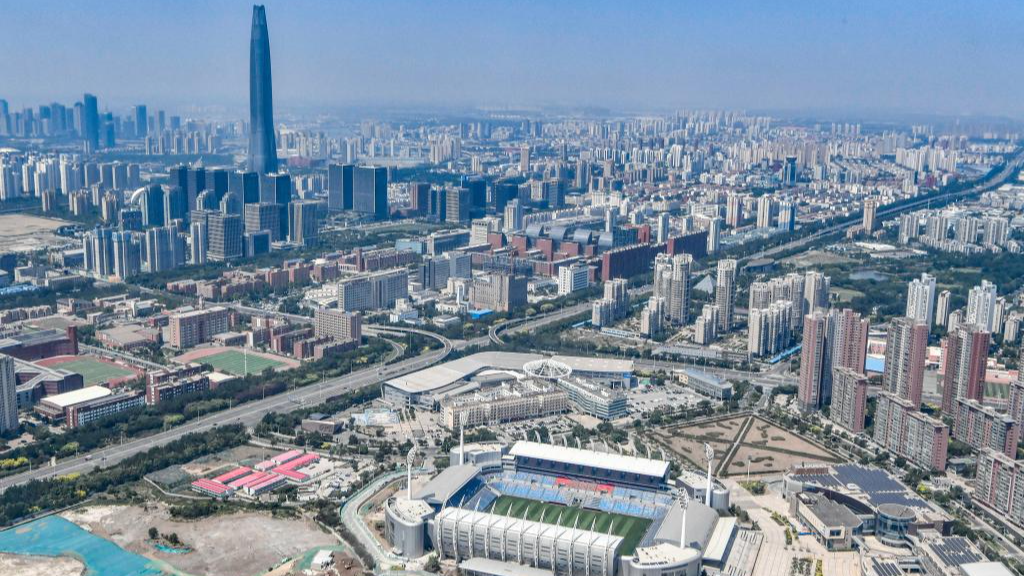
The Binhai New Area in north China's Tianjin Municipality, June 16, 2023. [Photo/Xinhua]
By Azhar Azam
China's economy continues to maintain a stable, high-quality growth momentum as value-added industrial output, the service sector, particularly information transmission and software and information technology services, consumption, high-tech manufacturing, fixed asset investment and trade generally posted healthy growth rates, data released on May 17 by China's Bureau of Statistics for April showed.
Many leading analysts and economists too have a strong belief in the Chinese economic strength as they reject the delusion that China's economy has reached its peak, arguing that it makes little sense in today's interconnected world. The world's second largest economy is facing some headwinds, primarily created by the U.S. and over certain property market challenges and the global economic slowdown, but it's capable of overcoming them and sustaining growth.
Rejecting the concept, a recent article in the Financial Times commented that although China's stock market took a battering, neither should this phase be categorized as "crisis" nor should the growth potential of the Chinese domestic market – "one arguably too big to ignore" – be written off, anticipating that "perhaps only China is 'the next China.'" Noting the private investments in artificial intelligence and the impressive progress in industrial robot installations and innovation, the report stressed that China, though still going through a major transition, had taken measures to stabilize the market and restore investor confidence.
Following its transformation into the "world factory" and experiencing the rapid urbanization in the past decades, which has enabled China to post miraculous growth rates in modern history for years – the Chinese economy is navigating a great transition, anchored in consumption-led, value-added, technology-driven, green and high-quality growth.
Higher reliance on domestic consumption, accounting for 73.7 percent of the country's economic growth in the first quarter of 2024, is a key feature and the strongest driver of China's economy and high-quality growth. Surging retail, foodservice and automotive sales and luxury spending, robust recovery of the hospitality sector, a steady increase in income, decline in urban unemployment, and the emergence of new patterns of consumption indicates efforts to boost people's spending power and pursue high-quality growth including strong policies to drive efficiency in innovation-driven economy.
Speaking in a recent session at the World Economic Forum in Davos, Australia's ambassador to the U.S. Kevin Rudd emphatically described the "core fact" that Chinese consumers were the best guarantor of China's economic future: "Remember, the scale of the Chinese consumer market is unprecedented in global economic history. I don't accept 'peak China' at all. I think it's intellectually and analytically flawed because of the untapped potential of Chinese consumer demand."

Visitors at the Wangxian Valley Scenic Spot in Shangrao City, east China's Jiangxi Province, September 29, 2023. [Photo/Xinhua]
Writing in Foreign Affairs magazine, Peterson Institute's senior fellow Nicholas Lardy earlier dismissed the flippant perception of "peak China" that underestimates the resilience of China's economy. China had overcome even greater challenges when it started the economic reforms in the late 1970s, he said, rebuffing the view of weakened household income and weak consumer spending confidence as China's real per capita consumption in 2022 (9 percent) when the country was severely impacted by the COVID-19 pandemic, climbed to 9 percent compared to the increase to 6 percent in real per capita income, which meant consumer confidence was high as households were willing to curtail their savings and ratchet up consumption.
The detractors – believing China's economic or financial collapse is imminent and the day of reckoning has eventually arrived and expecting the Chinese economy to slump, collapse, fail, or have a miserable year – are wrong, given that real estate did not spark a contagious wave of bank failures. And new housing projects, growing income and rising domestic sales, spending and electricity usage, among others, will invigorate China's domestic consumption.
While sectors like technology platforms, electric vehicles, green energy and electronics will remain the vibrant sources of China's innovation and growth – new quality productive forces, focusing on innovative techniques and technology breakthroughs to spur high-quality all-round development, China's contribution to three-fifths of the world's total renewable capacity and production of almost all of the world's equipment to make solar panels are ensuring that the Chinese economy continues to make a rapid transition.
Goldman Sachs and Morgan Stanley recently upgraded China's economic outlook, citing an increase in factory activity and exports. With the exports rebound showing a bright spot and China's measures encouraging families to buy homes leading to momentum, the country is gradually overcoming challenges.
After years of high growth, China is now in the process of creating a new growth pattern, aimed at accelerating high-quality development. This transition from high-speed to high-quality growth isn't easy. As International Monetary Fund Managing Director Kristalina Georgieva said, it's the "right fork in the road to take." China is determined to blaze the trail and turn itself into "the next China."
Azhar Azam, a special commentator on current affairs for CGTN, works in a private organization as a market and business analyst and writes about geopolitical issues and regional conflicts.

 中文
中文



